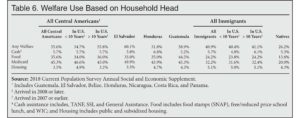Central American Immigrant Population Increased Nearly 28-Fold Since 1970
Steven A. Camarota and Karen Zeigler, Center for Immigration Studies, November 1, 2018
{snip} A new analysis by the Center for Immigration Studies of the latest Census Bureau data, which includes legal and illegal immigrants, shows that the size of the Central American immigrant population (from Guatemala, El Salvador, Belize, Honduras, Nicaragua, Costa Rica, and Panama) has grown enormously in recent decades. It also shows immigrants from the region often struggle with high rates of poverty and welfare use and low average incomes. The reason this is the case is {snip} due to their low levels of education, which, as their numbers have soared, have declined dramatically relative to natives.
Among the findings:
- The number of immigrants from Central America (legal and illegal) has grown 28-fold since 1970, from 118,000 to nearly 3.3 million in 2018 — six times faster than the overall immigrant population.
- {snip}
- Based on prior estimates by the Department of Homeland Security, slightly more than half of El Salvadorans are in the country illegally, as are about two-thirds of Guatemalans and Hondurans.1
- {snip}
- The primary reason so many Central Americans are poor and access welfare is that, as their population has grown in the United States, their education level relative to natives has declined dramatically:
- In 1970, 49 percent of Central Americans had not completed high school, compared to 42 percent of natives — a seven percentage-point gap. In 2018, 47 percent of Central Americans had not completed high school, compared to 6 percent of natives — a 41 percentage-point gap.
- In 1970, 4 percent of Central Americans had at least a bachelor’s degree, compared to 5 percent of natives — a one percentage-point gap. In 2018, 10 percent of Central Americans had at least a bachelor’s degree, compared to 38 percent of natives — a 28 percentage-point gap.
- Because such a large share of Central Americans have modest levels of education, the share of immigrants and their young children from the region who live in poverty is twice that of natives — 22 percent vs. 11 percent.
- Perhaps most troubling, 31 percent of the children (under age 18) of Central Americans live in poverty, roughly double the 16 percent rate for the children of natives. Also, 66 percent of the young children of Central Americans live in or near poverty.
- On average, Central Americans make only 61 percent as much as the average native-born American. Even Central Americans who have lived in the country for more than 10 years still only have 65 percent of the average income of the native-born.
- Given the large share of Central Americans with low incomes, it is not surprising that so many access the welfare system. In 2018, 56 percent of households headed by Central American immigrants used one or more major welfare programs, more than double the 26 percent of native households.
- Although illegal immigrants and new legal immigrants are barred from most welfare programs, the restrictions do not apply to all programs. Moreover, some states allow otherwise ineligible immigrants to access programs at state expense; and most important, immigrants, including illegal immigrants, can receive benefits on behalf of U.S.-born children, who are awarded citizenship at birth.
- {snip}
- Welfare use is common among both recently arrived and more established Central Americans. Among households headed by Central Americans in the country for 10 years or less, 55 percent used one or more welfare programs, while the figure is 56 percent for households headed by a Central American in the country for more than 10 years.
- {snip} Of households headed by El Salvadoran immigrants, 60 percent use at least one major welfare program; the figure is 59 percent for Guatemalans and 52 percent for Hondurans.
- Overall, Central American households’ use of cash welfare is similar to that of native households, but the share of Central American households receiving some type of food assistance is 2.5 times that of natives — 36 percent vs. 14 percent. The share of Central American households with at least one person on Medicaid is more than double that of native households — 45 percent vs. 20 percent.
{snip}
[Click on the table to enlarge it.]
[Editor’s Note: The original article contains additional tables, data sources, and end-notes.]
















